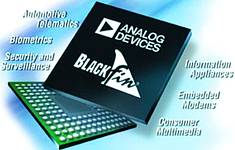

Analog Devices has released its next-generation Blackfin processor family which it claims delivers twice the performance and half the power consumption of conventional DSPs and embedded processors.
The ADSP-BF533 is a 600 MHz/1,2 billion multiply accumulate operations per second (GMACS) processor, while to low-cost ADSP-BF531 operates at 300 MHz/600 million multiply accumulate operations per second (MMACS). Both Blackfin processors combine best-in-class digital signal processing performance with microcontroller functionality and embedded operating system support, designed to meet the computational demands and power constraints of today's embedded audio, video and communications applications.
The processors require only 0,15 mW/MMAC at 300 MHz and at 600 MHz performance levels, the power consumption of the ADSP-BF533 is only 280 mW. To optimise the advantages of the Blackfin architecture's Dynamic Power Management capability, the new processors integrate an on-chip switching regulator that permits programmable control of the core voltage - from 0,7 V to 1,2 V - from a single I/O supply. This reduces overall system costs and external power supply components.
These Blackfin devices also support embedded operating systems such as Embedded Linux, ThreadX and Nucleus. In addition, the video optimisations within the Blackfin processors enable fully-programmable D1/VGA realtime video and multichannel audio without the complexity or inflexibility of dedicated hardware or heterogeneous dual-core approaches. Using the programmable Blackfin processors enables fast time-to-market and easy support for new and emerging media formats such as MPEG-4, H.264 and Windows Media, says ADI.
"Our new Blackfin family delivers embedded processing speed and power-efficiency that previously could only be implemented with ASICs or hardwired chipsets," said Brian McAloon, group vice president, DSP and System Products, Analog Devices. "As important, the 600 MHz milestone is only the first rung in the performance ladder as we continue to evolve this technology to address the embedded software developer's appetite for higher performance solutions."
"Blackfin is good at media processing, where most microprocessors are weak. Analog Devices has correctly identified a key growth segment, and with the company's strong reputation in media processing it's well poised to be a major player in this arena," said Jim Turley, president, Jim Turley & Associates. "The new Blackfin processors mix signal-processing performance with traditional microcontroller capabilities that are right for new multimedia applications and at a price point of only $4,95, it is a very compelling solution."
All new members of the Blackfin processor family are pin-for-pin and code compatible and offer new levels of peripheral integration, including glueless connection to an array of ITU-R 656 video encoders and decoders, as well as high-speed ADC and DAC converters at up to 65 MSa/s. The dedicated video port on all members of the family is supported by an innovative 2-dimensional DMA structure that significantly reduces software overhead and system power consumption for realtime video applications. Two dedicated serial ports support up to eight channels of IIS (I2S) audio.
Information from Analog Data Products. For more information contact them on 011 259 9400.

© Technews Publishing (Pty) Ltd | All Rights Reserved